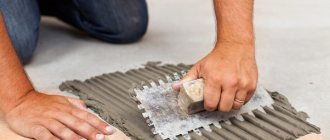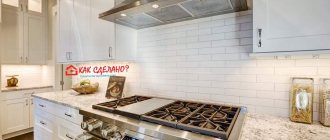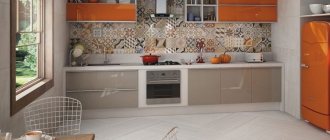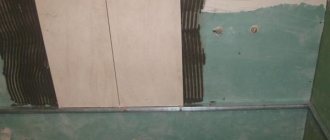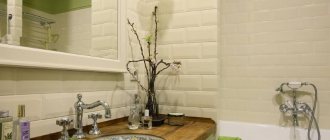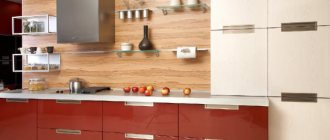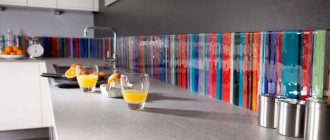It is the tiles that protect the walls from splashes of grease during cooking. Recently, brick masonry has become extremely popular. Today we will tell you how to properly lay hog tiles on a kitchen backsplash, and all the intricacies of this process.
In fact, the apron is one of the most vulnerable parts of the work area. An alternative to the “hog” is tempered glass - skinali, other ceramic tiles and even artificial stone. The choice is often made depending on one’s own preferences and the specifics of the interior design.
What are boar tiles?
“Boar” tile is one of the types of ceramic facing materials that imitates brickwork. Initially, lamellas were produced for the exterior decoration of facades, but nowadays manufacturing companies offer a wide range of tiles intended for decorating the interiors of buildings: bathrooms, kitchens, toilets and others.
The product got its name due to the similarity of the mold for casting the tile with a pig's snout. “Boar” has an oblong rectangular shape and bevels (beveled edges) that add volume, but products are also available without bevels.
The surface of this type of tile can be glossy, matte, semi-matte or textured (artificially aged, crackled), the color scheme is varied, but monochromatic (without applied drawings or patterns).
A little history
Example of façade cladding
Previously, façade tiles were called boar tiles. The finish imitated brickwork and was most often used on the facades of Art Nouveau buildings at the beginning of the twentieth century.
The informal funny name “boar” was strengthened due to the fact that the blank, covered with glaze, had two through holes at the end, which made it look like a pig’s penny. After being hit with a hammer, the blank split into two equal halves, having a smooth surface on the front side and a rough surface on the back. Thanks to this shape, the tiles were convenient to stack and transport.
Material advantages
The advantages of brick-like tiles include:
- Width of assortment.
It is possible to choose the material according to color and texture to suit every taste and for various interiors.
- Resistance to temperature fluctuations. When decorating a kitchen backsplash with tiles, you don’t have to worry about the integrity of the lamellas during intense heat load.
- High moisture resistance.
- Durability, resistance to chemicals.
- Easy to maintain: a wall lined with this facing material can be easily cleaned of soot or grease even with a damp cloth;
- Long service life of the product.
- Versatility of use (laying possible in any room).
The material is indispensable for those who value environmental friendliness!
What style does a hog tile backsplash fit?
A kitchen apron decorated with a “hog” harmoniously combines with many design styles:
- In a classic interior.
The tile attracts the eye, while simultaneously focusing attention on other interior details;
- Nordic, Scandinavian style.
It is a combination of glossy and rough textures (this tandem can be achieved by decorating the backsplash with textured tiles, and the walls with elegant wallpaper, or vice versa).
- Simple, deliberately uncomplicated country (or Provence) style.
The design of the room can be emphasized and refreshed by laying the walls with “brick” tiles. The slats complement the “rustic” image of the room;
- The interior is in an urban, industrial style.
(with a large number of details, furniture made of metal and glass) it will look more complete if you make a “hog” installation of not only the apron in the kitchen, but also a small section of the wall;
- Art Deco
The restraint and monumentalism of the Art Deco style goes well with the geometricity and strict lines of tile laying; a good result can be achieved by combining white lamellas with bright interior items, a black apron with light-colored furniture, or using tiles and decorative plaster for finishing;
- The colors of the lamellas are relevant for high-tech design: in this case, the seams are treated using grout in dark shades, emphasizing the deliberate roughness of the style.
ATTENTION! When choosing lamellas, think about the materials of what texture will prevail in the room and how the tiles will be combined with them. Beige or white products are universal for kitchen decoration - they will complement any style and will be combined with the color of other interior items. Also take into account the size of the room: dark tiles will visually reduce the space, while light ones will increase it.
Stacking vertical
A fairly simple way to finish a wall is to stack tiles vertically. Simply lay the tiles one after another and the result is a simple and practical interior design. Like the previous method, this option also works in favor of visually expanding the room - thanks to vertical straight lines.
Photo:
Design options
The tiles are available in two types:
- with a chamfer - the presence of beveled edges on the lamellas, which gives convexity and relief to the wall on which the installation is made;
- without chamfer – tiles with a flat surface, without beveled ends. To emphasize the severity of the brickwork, in this case it is advisable to use a grouting compound of a contrasting color.
IMPORTANT! Caring for an apron made with beveled facing materials requires more attention. Cleaning tiles with a pronounced texture will be a little more difficult than flat slats.
Peculiarities
Hog tiles are quite often used in kitchen backsplashes. Its shape and relief resemble brickwork.
Initially, the tile was used for facade decoration, and got its name due to two holes on the flat part, providing ease of transportation. They are the ones that visually resemble a pig's snout. But, this feature is unique to the domestic market.
The European buyer calls the tile “subway” because it is traditionally used for finishing subway stations and underground passages.
The pleasant appearance and comfortable shape allowed the “hog” to quickly occupy its niche in interior decoration. Modern designs of tiles have become more diverse, the decor is more pleasant and colorful. It can be produced with glaze or painting.
Popular tile sizes
The dimensions and proportions of the facing material are close to the proportions used in the production of bricks. The most common and popular tiles are 20x10 cm and 30x10 cm formats.
Manufacturing companies produce lamellas of various sizes, ranging from the smallest 10x7.5 cm to large 30x15 cm. The standard length of products varies from 10 to 30 cm, width from 7.5 to 15 cm, tile thickness can be 2 cm (at the center point facial plane).
Size range
The size of the boar tile can be varied. The following options are available:
- The smallest is 7.5x10 cm.
- The largest is 28.5x8.5 cm.
- The most commonly used is 10x20 (10x30) cm.
There are general recommendations that are developed based on size. Thus, large elements significantly reduce small rooms. Therefore, for small kitchens and bathrooms, use a size of 10x20 or less. Of course, when work is to be done in spacious rooms, you can combine different sizes.
Boar tiles are available in a wide range of sizes
How to choose grout?
To grout the seams of a kitchen apron tiled to look like brick, it is advisable to use two-component mixtures (latex or epoxy-based) that are water-resistant: the composition can be easily cleaned from the accumulation of soot, grease and other types of contaminants.
Mixtures of this type have good resistance to chemicals, do not darken and are designed to withstand temperature fluctuations and frequent washing.
Choosing the color of the grout mixture:
- white:
The most common option allows you to make the cladding more expressive (if the color of the tiles contrasts), the grout can act as a binding element for tiles of different shades or neutralize the complex color scheme of the lamellas. For a Scandinavian-style interior, a harmonious combination of white composition with facing materials of the same color is harmonious;
- black:
The composition is suitable for light-colored tiles and will emphasize the simplicity and elegance of dark-colored materials. Finishing the apron with tiles of different colors is an original solution, but choosing the tone of the grout in this case can be difficult, so the most suitable option would be black;
- neutral grout (beige, gray, dark and light shades).
Practical to use and favorably emphasizing the slats of classic colors. Also suitable for finishing seams on brightly colored items;
- color composition.
Choosing a tone lighter than the tile will make the surface of the cladding visually more prominent.
You can choose a grout that completely matches the color of the lamellas, or you can use a material of a completely opposite shade, getting an unexpected and original combination of colors.
IMPORTANT! By maintaining the width of the space between the tiles at 1.5-2 mm, they achieve emphasis on the facing material itself. With a width of 4-5 mm, the seam is visualized as a decorative element and requires very careful and accurate design.
Color solutions
The color, shade, texture of the tiles should harmoniously fit into the design of the room, complement other interior elements and correspond to the individual preferences of the owner of the room. Boar wall tiles are chosen from a variety of colors, focusing on the following:
- Black. Looks great in large rooms. When using it, visual accents are well placed in light colors.
- White. Considered a universal color. It can complement other colors, for example, black, blue, pink, shades of dark colors. But it can act as an independent primary color.
- Black and white gamma. Classic. Used in many interior design styles. White tiles with splashes or a belt of black (gray) color look great.
- Red. Decorating a section of the wall with this color will accentuate the attention of those present. But the color is somewhat aggressive. Therefore, it is recommended to use it in combination with other bright colors, for example, light turquoise, olive, green or blue.
- Blue. The color of calm and tranquility. Mainly used for finishing baths and toilets. When using panels with other colors in the ornament, gloss softens the composition. Successfully complements purple, turquoise and lilac colors.
- Compositions of soft tones (burgundy, turquoise, milky, brown and dark shades of other colors) are important to combine with other elements of the premises - furniture, curtains, wall decorations, etc.
Advice! When choosing the color of a tile or determining a combination of shades, it is recommended to familiarize yourself with photos of completed compositions on the Internet. Many well-known manufacturers offer ready-made original solutions, for example: Kerama Marazzi hog tiles, Ege Seramik, Absolut Keramika, Serenissima Cir catalogs and others. Before making a purchase, you should try to combine colors on exhibition tile samples.
Styling tools
To install and trim the lamellas, you will need the following tools and accessories:
- adhesive mixture for ceramic products;
- grinding float;
- composition for rubbing joints;
- rubber and metal (toothed) spatulas;
- building level;
- roulette;
- metal square;
- marker or chemical pencil;
- tapping cord for marking lines;
- drill (with a nozzle for mixing the solution);
- rubber mallet;
- a small angle grinder with a diamond wheel for cutting (grinder);
- metal profile or wooden strip (for fixing the first row of facing elements);
- rags, sponges (removing excess adhesive or mixture for rubbing joints).
ATTENTION! If you don’t have a construction float, process the cuts of the lamellas with a special “Turtle” grinding disc for ceramics, which is mounted on an angle grinder. Use an electric tile cutter to process beveled products - this will reduce the likelihood of damage to the product and reduce the amount of dust during work. If you are laying lamellas without a chamfer, it is permissible to use a manual one.
Preparatory work
Before installing the kitchen apron, you must complete the following preliminary work:
- clean the wall of old paint and plaster;
- use a level to check the evenness of the surface for hog cladding;
- degrease the wall and apply a primer, wait until it dries completely;
- measure the distance from the floor to the place where the first row of slats will be laid out;
- Taking into account the result obtained and the type of installation, apply markings to the base;
- drill holes below the line of the first row, drive in plastic dowels;
- install a metal profile or wooden plank using screws. The top of the fixing strip must coincide with the mark of the lower level of the cladding;
- make a preliminary layout of the tiles on the floor, selecting elements by color and format, check each lamella for chips and cracks;
- Prepare the adhesive immediately before starting installation. It is advisable to use a mixture that is intended for use in rooms with high humidity and temperature fluctuations. You should not dilute the entire contents of the container at once - mix the glue in the amount that you will use per hour of work. The adhesive properties of the solution decrease over time.
IMPORTANT! Always purchase facing material with a small reserve (add another 10% to the required quantity) - in case of careless cutting or falling of the lamella, you can always replace the damaged element.
Why is it called that?
The question “What is this?” often occurs to people when a designer starts talking about a pig in the kitchen.
This tile is called this way only in Russian-speaking countries. This is due to the tile manufacturing process: its blank at the end has two holes that resemble the heels of a pig. The nickname passed from production to the people, and it stuck.
In the West, this tile is called “Metro”. As the name suggests, it is installed in the subway and other public places because it looks simple and neat. Initially, buildings were lined with boar, then metro crossings. Unfortunately, information about who began to use it to decorate the house has not been preserved.
Apron installation
- spread the adhesive using a spatula on the back of the tile. The surface of the applied composition should have small depressions and grooves;
- place the solution on the surface of the base - the “hog” is thick and heavy, so to improve the adhesion of the surfaces, a layer of glue is necessary both on the wall and on the slats;
- Apply at one time the amount of mortar required to lay 2-3 tiles;
- press the “brick” against the wall with force or by lightly tapping it with a mallet;
- the lower part of the tile should rest against the fixing profile or rail, which will prevent possible slipping of the cladding;
- to maintain the same distance between the lamellas, insert plastic crosses into the space between the tiles;
- lay out all subsequent tiles, checking the evenness of laying each row with a level or vertical plumb line (you can use a level bar);
- an hour after completion of installation, remove the dividing crosses and clean the tile joints from excess mixture with a rag or sponge;
- After the glue has dried (average time - 24 hours), remove the fixing metal profile or rail.
IMPORTANT! Lay out the first row, starting to install the slats from the part of the wall away from the entrance.
To cover a kitchen wall, the following types of installation are used:
- traditional - the lamellas are arranged horizontally or vertically, repeating the pattern of the brickwork. This is the simplest method, suitable for a beginner. There is another option for classic installation - with the elements of each subsequent row shifted by 1/3 in relation to the tiles of the lower level;
- stacked (horizontal and vertical) - tiles are placed one above the other, matching them in width or length. Vertical installation is suitable for rooms with low ceilings, horizontal installation visually expands the area of the room;
- diagonal – laying the “hog” at an angle of 45˚;
- “herringbone” – installation of elements at an angle of 90˚ relative to each other, a beautiful and original method, but requiring skill and experience;
- in a checkerboard pattern - alternating tiles laid vertically and horizontally can be made from single or double elements.
IMPORTANT! For the stacking method, the choice of color of the grout mixture plays a big role, since attention is focused specifically on the seams.
Generalization on the topic
As you can see, the tile, which has such an interesting name, has a large number of operational advantages. With its help today it is easy to implement classic design concepts and create modern styles. But if you give preference to the described option, you must be prepared to pay more for the finishing than purchasing traditional tiles. The boar is not suitable for the first experiments in mastering repair technologies. Laying such tiles requires certain experience and knowledge.
Grouting joints
- Proceed to decorate the seams with the mixture only after the adhesive solution has dried;
- dilute the composition with water, scoop a small amount onto a soft rubber spatula;
- with little effort, rub the mixture into the entire depth of the space between the tiles;
- after finishing the process, use the corner of a spatula to fill out the seams - this will give them a uniform and even appearance;
- 40 minutes after grouting, carefully remove excess mixture;
- When the solution is completely dry, wash and polish the kitchen apron.
If necessary, fix the baseboard.
IMPORTANT! Do not use a spatula made of rubber or black plastic - marks may remain on the ends of the tiles that will be difficult to remove.
Method 2 – Cutting corners with a grinder – master class from a “virtuoso”
And if you don’t have a certain skill, then this process cannot even be called sharp, because you will have to grind the ends of the tiles until the desired angle is obtained. This example, by the way, can often be seen in numerous videos, and if you have the financial opportunity to ruin a bunch of tiles trying to repeat after that virtuoso, then you can try. We believe that after a lot of waste and several hours of wasted time, it will be possible to achieve a more or less correct angle, but, alas, it will not be possible to see a smooth and even surface of the ends. The cutting wheel is guaranteed to leave notches, which will have to be hidden with the same grout, and this is already a “hack job”.
Theoretically, this can be done in an even more ancient way - grinding with a file - but why, if you have a modern tool? If you’re going to kill time, then do it with impeccable work, the way specialists do it.
Difficulties in laying material
Careful wall preparation
The evenness of the base plane before installing the facing elements can be assessed using a construction, water or laser level. If there are no such devices, use the following method: drive a nail into the upper corner of the wall and tie a long (to the floor) nylon thread or fishing line with a weight to it.
When the plumb line takes a stable position, fix its lower part by driving a second nail into the lower part of the wall and tying a thread on it. This way you can control the deviations of the installation from the vertical plane. Horizontal deviation can be determined using a transparent flexible tube filled with water (at least a meter long). Well, or using a level.
Depending on the degree of damage to the base surface, choose how to fix the problem:
- using putty (suitable for correcting unevenness up to 1 centimeter) or plaster (from 3 to 5 centimeters);
- installation of plasterboard sheets on a pre-constructed frame (with height differences of more than 5 centimeters).
Important! Be sure to appreciate the evenness of the walls!
Accurate trimming of cladding
When decorating the outer corners of a room with a “hog”, it is necessary to fit the lamellas at 45˚ (the sawdust of the back side of the tile) using an angle grinder and diamond discs.
ATTENTION! Set the minimum number of revolutions on the grinder - this way the cutting will be precise and the risk of chipping the tiles will be minimal. After this, carefully sand the edges of the lamellas with sandpaper.
Finishing internal corners:
- when laying tiles without a chamfer, cut out the joining elements at an angle of 45˚ and align the edges, check the resulting angle for evenness;
- When installing beveled tiles, make a bevel of the product at an angle of 45˚ and, using a grinder, make a trapezoidal cutout that follows the profile of the lamella.
After cutting the tiles, be sure to clean its surface from dust and crumbs.
ATTENTION! A simple way to design external and internal corners when installing a “hog” is to use ready-made ceramic corners. You can also purchase small square elements for this purpose.
Maintaining strict horizontal laying
To install rectangular tiles, they often use the “staggered” method - in a checkerboard pattern with offset options of 20%, 30%, 50%. To maintain the evenness of the horizontal masonry, strict control of the distance between the floor and the beginning of the first row of facing elements is necessary.
A “sliding” installation line can ruin the appearance of the kitchen.
The size of the tile seam
You can often hear advice that it is necessary to leave a gap between ceramic products during installation of at least 5 millimeters. Thick seams require very careful execution and do not always look aesthetically pleasing and beautiful.
Beveled tiles require special care in finishing the seams, since the relief of the elements involuntarily attracts close attention.
The color of the grout is not of primary importance, the most important thing is that all intertile spaces must be narrow and perfectly even. When making a wide seam, it will be difficult to fulfill this condition, so a gap of 2 millimeters is considered optimal (it is especially important to adhere to this rule when using the traditional method of installing beveled tiles).
When laying a “hog” without a chamfer, the permissible size of the tile joints is 5 millimeters.
Installation of overhead accessories
In some cases, it becomes necessary to mount additional accessories on the surface of the apron: sockets, shelves, holders. Choose a place to attach parts only on a horizontal line (seam).
Be sure to make sure that the outermost part of the accessory does not coincide with the facet of the tile, otherwise the product will look as if it is “hanging” in the air.
Marking vertical seams
When installing lamellas, it is necessary to accurately calculate the number of vertical rows of the apron: the edge of a wall or floor cabinet, the connecting plinth (installed to create a smooth transition between the cladding and the surface of the slab or furniture) may align with the central part of the tile, as a result of which the fit will not be tight.
Main nuances
The technology for laying boar tiles on a kitchen backsplash is significantly different from working with ceramic or porcelain tiles. The work is complicated due to the texture and the presence of beveled, rounded corners (not on all models).
How to trim hog tiles
As already mentioned, trimming is necessary when laying outer rows and framing protruding objects (for example, gas pipes). Trimming can be done with a tile cutter or a grinder with a diamond blade. The latter should operate at the lowest possible speed, which will reduce the number of chips.
Processing internal and external corners requires cutting the back side of the tile at 45°. Having marked the element and sawed it off, the edges are sanded with sandpaper. In addition, pay attention to a number of features:
- After cutting the corner tiles without a chamfer, align them with each other and make sure that the resulting corner edges are even.
- Installation of beveled tiles is carried out with an additional trapezoidal cutout that follows the profile of the lamella.
Healthy! The easiest way to frame corners with boar tiles is to purchase and install a ready-made (assembled) ceramic corner.
Joints between tiles
To process the gaps between the hog tiles on the kitchen apron, special mixtures of different compositions are used. Each of them has its own disadvantages and advantages.
- Epoxy. They have excellent performance characteristics, are absolutely waterproof, durable, and inert to prolonged exposure to aggressive detergents. Service life reaches 50 years.
- Polyurethane. They are characterized by high elasticity and the presence of fine-grained components. In most cases they are used for processing thin seams. Often used to treat surfaces where the base is sheets of plasterboard or other material prone to cracking. The disadvantage is the relatively high price.
- Acrylic. The optimal choice for bathrooms, toilets, work aprons - places exposed to frequent contact with water. They provide 100% tightness of joints, but are not able to withstand mechanical loads.
- Latex. They have high elasticity and do not crack under prolonged mechanical and thermal influences. Used for processing wide (more than 5 mm) gaps.
- Silicone. They have excellent waterproofing properties. The disadvantage in this case is the tendency to destruction when exposed to high temperatures (the area behind a gas or electric stove).
Important! Cement-sand grouts are among the simplest types; they are not used with glossy coatings, therefore they are not considered in this case.
When choosing grout for the joints between the hog tiles on the kitchen apron, pay attention to the color and style of the interior of the room. For example, a neutral grout with a woody tint is suitable for treating beige walls. The finishing of the combined composition is done using shimmering fugue mixtures.
Useful tips
- It is more convenient to install the slats before installing the furniture in the kitchen, but in this case it is necessary to make precise markings of where the interior items will be located. It is permissible to make an apron after placing the elements of the kitchen set;
- when calculating the required amount of adhesive when laying hog tiles, remember that the product is heavier than standard material of the same size, so more mortar will be required to fix it on the wall;
- When dismantling the slats or metal profiles after the glue has completely dried, under no circumstances pull the support towards you: you may accidentally tear off the tiles of the first row. To avoid this situation, remove the rack in a downward direction.
With the help of ceramic tiles “boar” you can implement the most daring design solutions in any kitchen, regardless of its size, wall color and interior style.
The only drawback of the material can be considered the cost, which is significantly higher than the price of ordinary tiles.
The master's work is afraid
Laying such demanding tiles as “hog” requires experience and some ingenuity. Therefore, to get a good result, we advise you to invite a good tiler. In addition, it is necessary to strictly follow the technology for laying ceramic tiles and use only certified materials: putties, primers, tile adhesives and grouts. Don’t skimp on high-quality finishing materials, then you won’t have to regret wasted money and time.
Don’t be afraid of the difficulties of installing a “hog”, because all of them can be overcome, and the result is so good that over time you will forget about them and admire the beautiful design of your room.
Examples in the interior
DO YOU HAVE ANY QUESTIONS?
Ask a specialist
